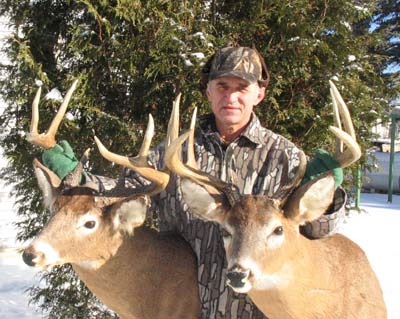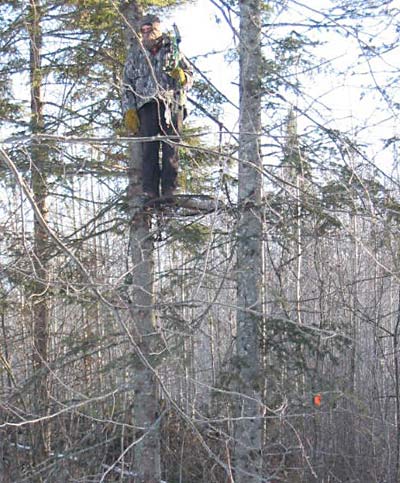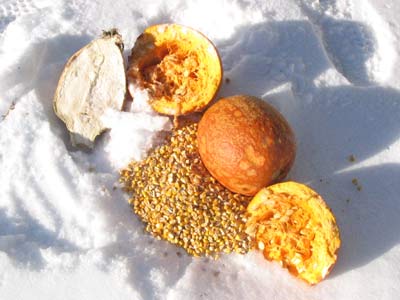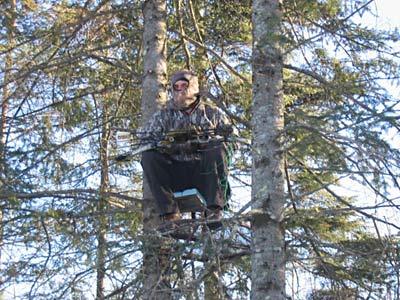|
How to Bow Hunt Big Mature Bucks Over Bait
by Carl Kozak
Even though it was 49 years ago, I still vividly
remember shooting my first buck. I was in Lugerville,
Wisconsin, a small community in the northern part
of the state.
As I was proudly standing over my buck, with my dad, uncles and cousins congratulating me, my Uncle Louie called me a "lucky stiff." He had hunted many years without killing a buck.
In the years since 1957, I have harvested many small bucks and several large ones. I've also thought often about my uncle's comment. Luck does play an important part in the success of any hunt, but to harvest a mature whitetail with a bow also requires great thought in positioning yourself.
 Each
buck I shot was under different circumstances,
but I always tried to build on that "lesson learned"
to increase my chances for the next year. I am
now convinced that harvesting a trophy whitetail
with a bow is almost impossible unless extreme
luck, preplanning and precautions are put in place. Each
buck I shot was under different circumstances,
but I always tried to build on that "lesson learned"
to increase my chances for the next year. I am
now convinced that harvesting a trophy whitetail
with a bow is almost impossible unless extreme
luck, preplanning and precautions are put in place.
It was not until the late 80s that I discovered tree stands. Before this time, if there was a likely spot, I would shimmy up a tree, sit on a limb and hope for the best. This method was not too comfortable for long periods of time and made for awkard shots. It was also always a challenge to stay in the tree without falling. However, hunting up high gave me more sightings and the harvest rate when up, as well as the understanding of how these deer function in their environment. The more deer I observed, the more I could see how they react to various conditions and situations.
When baiting (the use of feed) became legal, it was a good bet to bow hunt over corn, apples, beets, pumpkins, cabbage, and even green tomatoes. My typical pattern and tactic was to put up a tree stand, place some feed 15 to 20 yards out and hunt the stand. I would continue to bait, until the opportunity presented itself for a good shot. I wouldn't pass up many chances, as venison is a favorite meal in our house. I was always hoping for a chance at the "big boy," but I guess I never waited long enough.
 Since retiring two years ago, I have sat for long hours, day after day. I've passed up many small deer, but again I wouldn't see the big bucks (even when I knew some were in the area). I contributed my lack of success to bad luck. But after analyzing my methods, I concluded I was not putting the odds in my favor. I figured that by baiting and getting the does to come in and leave their scent, the buck would follow; what better decoy and scent was there than a real live doe standing in front of me so the big buck would come charging in? I could march home and be the envy of everyone. This tactic is good but again extreme luck plays the biggest role. Since retiring two years ago, I have sat for long hours, day after day. I've passed up many small deer, but again I wouldn't see the big bucks (even when I knew some were in the area). I contributed my lack of success to bad luck. But after analyzing my methods, I concluded I was not putting the odds in my favor. I figured that by baiting and getting the does to come in and leave their scent, the buck would follow; what better decoy and scent was there than a real live doe standing in front of me so the big buck would come charging in? I could march home and be the envy of everyone. This tactic is good but again extreme luck plays the biggest role.
These big, mature bucks get big because they are smart. They are wary animals whose senses are far sharper than ours. The greatest advantage is an incredible, powerful nose. They know human scent means danger!
I concluded if I can cut down their "smell advantage," still hunt over bait and sit in a tree stand, I can increase my odds. Scent blockers, scentless soaps, carbon suits do help, but don't fool yourself into thinking deer will never smell your presence; they will. However, there are several rules, that I believe if followed, will increase your odds and you will not be wasting your valuable hunting time.
Before I get into my rules, just keep in mind that these big guys are the four to eight-year-old dominant bucks that take no chances. I have observed (and quite likely you have, too) a mature buck at a distance that has circled the bait pile, picked up my scent and disappeared without ever coming into bow range, like the lyrics in The Thirty Point Buck, "there he was gone." I have left my stand feeling dejected and outsmarted, but somewhat excited because I came close to the big guy. But it takes only once for them to scent you and they will never, and I mean never, come back and eat your feed during daylight hours.
 Here are my most important rules when bow hunting big bucks over bait: Here are my most important rules when bow hunting big bucks over bait:
1. Stand placement. I place my stand in a tree that will provide a good cover background like in a spruce tree with a lot of limbs. I do not want to be silhouetted like I may be in a limbless tree. I never stand with cover in front of me as it hinders my ability to get my bow up and shoot. I don't expect to shoot 360 degrees; rather, I settle for a very small window of a few feet to get a shot off. I do this because it automatically eliminates any movement trying to twist around, thereby eliminating any movement the buck can spot. I have only one possible alley to shoot through.
2. Bait Placement. I place my bait at least 50 to 80 yards from my stand. If I had a choice I would drop it from a helicopter to eliminate scent; this is where scent eliminators help. I do not expect to shoot a deer that far away, but it helps decrease the deer's chance of scenting me. They will almost always circle downwind of the bait, by at least fifty yards. When they do, they will pass within shooting range of me and can present a good quartering-away shot.
 3. Pay Attention to the Wind. I never hunt the stand when the wind is drifting towards the bait pile. If the wind is in my back I will not stand there. 3. Pay Attention to the Wind. I never hunt the stand when the wind is drifting towards the bait pile. If the wind is in my back I will not stand there.
4. Hunt the Stand Infrequently. I hunt the stand once or twice at the most. After I bait, I stay away for at least 24 to 48 hours. This gives time to reduce my scent, have them find the bait, and have them feel safe to enter and eat. The third or fourth day, I sneak into my stand three to four hours before evening to help eliminate some of my scent I leave when entering. If they hear me come in, I usually start the process all over in another spot.
To reduce chances of the deer hearing me, I pick a spot away from the bedding area. I also never go to the bait pile, as tempting as it is, to investigate tracks, amount of bait consumed, etc., because I will leave my scent and a red flag alert. There will be plenty of time to do that after the buck is tagged. Is it a guarantee for me? No but I believe it will increase my chances.
5. Hunt the Long-Nose Doe. Lastly, I feel I must pass along my son Ben's advice. He believes that in order to increase the odds of harvesting a big buck, first spend some time hunting the six or seven-year-old long nose doe that lives in the area. She is as likely to bust you as the big dominant buck.
Good luck! It is great to be retired to have the time to hunt this method. |
